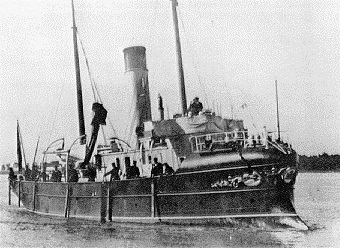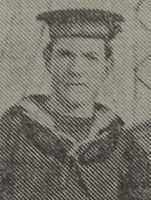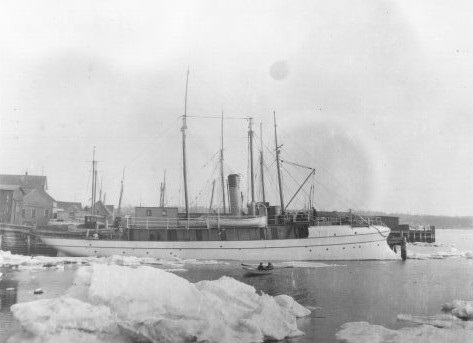|
HMCS PETREL
Auxiliary Patrol Ship
A sister ship to Curlew and Constance, PETREL was built as a fishery patrol vessel at Owen Sound in 1892, but did not see salt water until 1905. Between 1914 and 1918 she was employed frequently as a patrol or examination vessel on the east coast though with a maximum speed of 7 knots, her ability to pursue ships that did not obey a request to stop was limited. After the war she reverted briefly to her fishery patrol duties before being sold in 1923.
A Brief History of the Ships of the Royal Newfoundland Navy
Below is the history of HMCS PETREL courtesy of Harry Holman from his blog Sailstrait
A Yacht it was Not – the Dominion Steamer PETREL
With her ram bow and sleek lines the vessel looked a lot like a small yacht when she came into Charlottetown Harbour for the first time in 1905. One could easily mistake the reason why the PETREL was cruising eastern waters. Was this the pleasure ship of a wealthy industrialist? Indeed the gushing description of her interior which the Guardian borrowed from the Pictou Standard re-enforced the impression.
It seems almost impossible that such a small craft can be made so comfortable and roomy. Every alteration gained room and comfort. The engineers’ and officers’ quarters and mess room are fitted with every modern convenience. The pantry is fitted in a style that would compare favorably with any the modern ocean liner can produce. Hot and cold water, steam heaters, and the finest equipment of china of any craft of her kind. The master’s dining room, which is immediately aft of the officers’ quarters, and the pantry reminds one of a miniature palace. It is only 12×22 feet and on each side is a beautiful plush settee of the finest red silk plush. The room is also beautifully carpeted, which with the beautifully enamelled walls makes as neat and pretty a dining room as one would wish to see. Just aft of this room is the master’s sleeping apartments, which are fitted on a par with every other part of the vessel. On the main deck is the chart room, in which are all the necessary charts and other equipment and flags for the international code signals.
The D.G.S. PETREL was to be a frequent visitor to P.E.I. waters – not as a pleasure cruiser but as a patrol vessel in the years before Canada had a navy. Her job was fisheries protection but she took on all sorts of tasks that a government boat might be expected to have and for several years her main port was Souris, overseeing the fisheries of the eastern Gulf.
The PETREL was not a new vessel in 1905 but was new to salt water. She was launched in late 1892 from the Polson Ironworks yard in Owen Sound Ontario and was the last built of three near-identical armed patrol vessels designed to target illegal American fishing on the Great Lakes. When tensions on the lakes lessened her sister-ships the CURLEW and CONSTANCE were transferred to the East Coast and were frequent visitors to Island harbours – the CONSTANCE was later to serve as a steamer on the Charlottetown to Pictou service. Meanwhile on the lakes the PETREL had been rendered obsolete as American fishing craft turned more and more to high-powered engines and the Canadian vessel could not keep up. On the East Coast sail was still in heavy use for the fishing fleets.
The PETREL was 116 feet long, 22 feet wide and drew 9 feet. In 1905 she carried a crew of 22 men and the ship was armed with Ross rifles and Maxim-Nordenfeld quick-firing [machine] guns. She appears to have been re-built at the time of her transfer east. Originally fitted with a 54 horsepower engine, by 1905 her 400 horsepower coal-fired engine was said to be able to move her at 12 knots but she likely fell short of that as a working speed. She was, however, more dependable than the vessel she replaced – the unpowered schooner Kingfisher which had been based for several years in Souris. The PETREL monitored the activities of visiting American vessels and kept an eye on the local vessels seizing and destroying illegal nets and lobster traps. Still, the luxurious accommodation was not entirely wasted on fisheries protection officers as the following article from the 1907 Sackville Tribune suggests:
Rev. C.F. Wiggins returned Saturday from one of the most enjoyable trips of his life. He was absent about a fortnight, the first week being spent in Summerside and Charlottetown, while the second week was spent on board the government cruiser, PETREL, in company with Sir Louis Davies , of Ottawa [at the time a supreme Court Justice] and Mr. Hyndman of Charlottetown. They sailed through the Bras d’Or Lakes, visited Sir Graham Bell, called at Sydney, fished trout to their hearts’ content and had a good time generally. The PETREL landed Mr. Wiggins at the Narrows C.B., whence he took the train for Sackville.
In 1912 the PETREL, CURLEW and CONSTANCE were all fitted with minesweeping gear to assist the operations of the newly formed Canadian Navy and on the outbreak of war in 1914 they were was taken over by the navy for examination duties and coastal patrol. The Dominion Government Steamer PETREL became H.M.C.S. PETREL. She spent much of the war in the Bay of Fundy but when the navy added submarines to their fleet the PETREL was transferred to the Bras d’Or lakes and used to train hydrophone operators. Like many other vessels the end of the war ended her government service although she continued to be listed in the Mercantile naval List as belonging to the Minister of Marine and Fisheries until the 1924 edition when she was owned by Labrador Goldfields Ltd. of Montreal. Labrador Goldfields turned out to be a scam stock operation earning thousands of dollars for its Montreal owners. It appears that PETREL may have been briefly re-united with sisters CONSTANCE and CURLEW as they were both leased to Labrador Goldfields by their Cape Breton owner, Wentworth MacDonald.
In 1927 the registration for the ship was transferred from Ottawa to Sydney and John T. Cruikshanks of Sydney was the owner – some sources note that the ship had been seized for smuggling at the time. Another Cape Bretoner, George Burchill became the owner in 1933. The PETREL was wrecked on the Magdalen Islands in June 1934 and her remains lie near the N.E. end of the Dune du Sud close to Grande Entrée. Divers can still visit her although little is left of the vessel, now over 120 years old.
Commanding Officers
Mate, Milton Robert Janes, RNCVR - 29 May 1918 - unk
They shall not be forgotten
Photo and Documents
CGS PETREL
|




